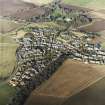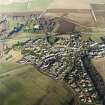Auldearn, Doocot Road, Boath Dovecot
Dovecot (17th Century)
Site Name Auldearn, Doocot Road, Boath Dovecot
Classification Dovecot (17th Century)
Alternative Name(s) Doocot; Auldearn, Dooket Hill, Doocot; Auldearn, Castle Hill; Boath Doocot
Canmore ID 15562
Site Number NH95NW 8
NGR NH 91726 55626
Datum OSGB36 - NGR
Permalink http://canmore.org.uk/site/15562
- Council Highland
- Parish Auldearn
- Former Region Highland
- Former District Nairn
- Former County Nairn
NH95NW 8 91726 55626
(NH 9172 5562) Dovecot (NAT)
OS 6" map (1906).
See also NH95NW 11.
Boath Dovecot is 17th century and is now the property of the National Trust for Scotland.
NTS List 1959
Boath Dovecot, situated on Castle or Dooket Hill, is circular, with an external diameter of 5.7m. It has one string course, and has been extensively modernised and re-roofed.
Visited by OS (RD) 22 November 1965
NH 917 556 Structural analysis and record of the late 17th to early 18th-century circular doocot was undertaken. Assessment of the fabric revealed clay-bonded masonry with a succession of lime-based pointing mortars and harls, the latter employing both marine and river sand aggregate.
Sponsor: National Trust for Scotland
J Millar 2000
Scheduled with NH95NW 11 as Dooket Hill, motte and doocot, Auldearn.
Information from Historic Scotland, scheduling document dated 21 December 2000.
Publication Account (1995)
The dovecote which served an earlier Boath House stands on a hill above the town of Auldearn. It is a small circular dovecote built in the later 17th century; the exterior is harled, with a single ratcourse, and the conical roof slated with a circular entrance for pigeons at the apex. Above the door are six flight holes in a framed stone panel: a similar set of flightholes to the rear are now blocked and harled over. The inside is lined with nestboxes for the pigeons.
The dovecote stands within a much earlier earthwork, all that remains of the old castle of Eren built about the middle of the 12th century from which Auldearn (Old Eren) takes its name. This was one of a number of fortifications built to maintain the authority of the Scottish kings in Moray, then a centre of revolt. In this castle in the 1180s William the Lion issued his second charter to the burgesses of Inverness. At present a circular earthen bank of some 28m diameter can just be made out, running round the edge of the hill and much overgrown with bushes. The 12th-century castle may have consisted of wooden buildings within the earthwork, which would have been crowned with a stone wall or timber palisade. It became ruinous in medieval times. Later a historic battle was fought closeby: Montrose, fighting on behalf of King Charles I, raised his standard here before the battle of Auldearn on 9th May 1645, at which he defeated the Covenanting forces. There is an explanatory notice on the site with a plan of the battlefield.
Information from ‘Exploring Scotland’s Heritage: The Highlands’, (1995).
Measured Survey (19 April 1999 - 22 April 1999)
The structure of Boath Doocot itself is located on the centre of the levelled
summit of the motte (NH95NW 11). This striking circular edifice has variously been ascribed to the seventeenth century.
On-going conservation work upon the structure had necessitated the removal of cementitious harl on the exterior. This presented an opportunity to examine the masonry fabric of the structure including the slight surviving remains of earlier limebased exterior surface finishes.
The doocot is a well-proportioned cylindrical structure of 4.95m - 5.0m in diameter, some 4.70m – 4.75m from threshold to wall head, and 7.45m to the apex of the roof. The austere exterior contains relatively few architectural features. These include an entrance with unadorned surround to the SE, 002, a perching (or ‘alighting’) ledge in the form of protruding ashlar string course at 2.05m - 2.15m above the threshold, 003, and a plain run classical cornice at the wall head, 005. The latter displays an ogeefillet- and-ogee profile.
Centrally set above the door exist a series of flight holes in two tiers of three formed from two vertically-set pierced sandstone slabs, 015. These in turn are framed by two slightly splayed fluted consoles, 016, supporting an architrave whose moulding has largely weathered away, 017. A third tier of flight holes may have existed above the architrave, as defined by straight ashlar jambs, 021, rising to the cornice. This is now infilled with modern cemented brickwork with an external cement skim that is pierced by a single central flight hole, 022. A similar feature, 023, exists just below the wallhead on the NW side of the doocot. This has been blocked in an identical manner to the first, 024. Three further flight holes – now blocked – were positioned just above the protruding string course at intervals around the structure, 018 to the ENE, 019 to the NW and 020 to the SSW. These had been subsequently blocked with mortared rubblework, 032, 033 and 034 respectively.
Entering the doocot across the coarsely paved threshold, 027, the lower parts of the structure are obscured by some 0.5m of guano and peat, 040. Small sondages dug through this on two sides of the structure revealed possible remains of a masonry or paved floor structure, 036 and 037, but too little was exposed to gain an impression of its character. A vertical wall face rose to some 0.7m above this approximate floor level, 029. Above the latter the interior is lined with 14 tiers of simple square nesting boxes formed of both carefully tooled sandstone blocks and unworked slabs (of shale?), all well tied into the rubblework the wall behind, 028. The nesting boxes are well-preserved throughout the structure and number 515 in total.
Internally the combined 015 / 021 pigeon entrance is divided into three levels by horizontally set slabs that run to the interior wall face.
Above the uppermost tier of nesting boxes the internal wall face continues to rise up for a further 0.20m – 0.25m, 030. A substantial socket within this to the to the W,031, is likely evidence for a joist running across the doocot to which was affixed the upper end of a potence or revolving arm supporting a ladder that permitted access to the nesting boxes. A partly damaged area of the 030 masonry approximately opposite the 031 socket may have been the location for the other end. Evidence for the lower pivot socket of the potence may still survive beneath the guano infilling the interior.
The roof structure, 035, is wholly modern. It is uncertain whether this closely reflects the original arrangment. Likewise it is unknown whether the existing slates were reused from the original roof.
The general walling was wholly exposed at the time of the survey and is of random rubblework. This consisted of miscellaneous field stone and a quantity of sandstone slab that gave some impression of regularity - 001. Dressings were of a light finegrained sandstone. Apart from the architectural features of the exterior described above this stone had been employed for an ashlar course at the wallhead, 004, upon which the 005 cornice had been laid.
To inform the on-going conservation process a specific study was requested for evidence of the bedding mortars, harls and limewashes used in the original construction.
The masonry of the 001 walling is ‘clay bonded’ with locally derived clayey-silt, 006. Internal pointing mortars vary between the local subsoil bound with some lime, to a hard higher lime mortar with sharp sand aggregate, 014.1 and 014.2 respectively.
Externally the walls had been pointed up / dubbed out with a hard lime mortar similar to 014.2, 007. It had then been prepared for harling with limewash (to form a bond), 008, and coated with a very sharp marine harl (i.e. using beach sand containing much comminuted sea shell), 009. The latter may have been partly intended to even out some of the irregularities of the wall surface and in some areas more than one application was apparent. 009 was then overlain by a thin application of finer harl with an aggregate of sharp river sand in one or two coats, 010 and 011. Very slight traces of a further application were recorded, this using a similar river sand aggregate but with a much higher lime content, presumably for durability, 012.
There were no surviving areas of the intended final surface finish or the presumed limewash over. It is thus uncertain whether the structure had had a coarse harl finish, a pressed back harl or a smooth plastered exterior. It would appear that the surface preparation described is entirely original work.
In recent decades the exterior of the doocot had seen some cementwork patching, 039, and a resurfacing in a hard cement-based harl upto 4cm thick in places, 025. This was the finish removed during the present conservation works. The cement harl had been pained with a modern white masonry paint, 013.
While in an excellent state of preservation and generally structurally sound there was some evidence that the structure had settled somewhat on its NE side. Minor structural cracking reflected this movement, 038.
It is unclear when the doocot was constructed. By its general architectural form and its few decorative details – the cornice and centrepiece above the entrance – a mid- 18th century date would appear more suitable than the 17th century date generally ascribed (perhaps centring upon the 1740’s – pers. comm. J Simpson).
Information from NTS (SCS) December 2013








































